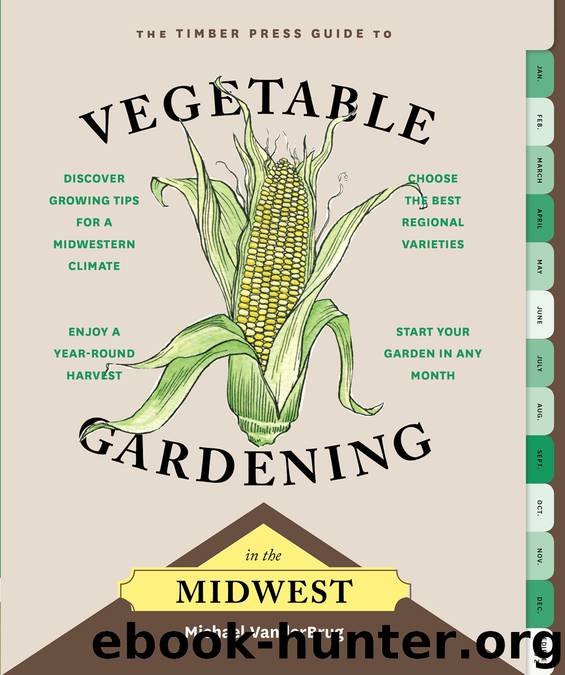The Timber Press Guide to Vegetable Gardening in the Midwest by Michael VanderBrug

Author:Michael VanderBrug
Language: eng
Format: epub
Publisher: Timber Press
Published: 2015-11-15T05:00:00+00:00
Beans
Arugula
Broccoli
Cucumbers
Beets
Brussels
Eggplants
Cauliflower
sprouts
Peppers
Celery
Cabbage
Pumpkins
Kohlrabi
Carrots
Summer squash
Lettuce
Kale
Tomatoes
Peas
Leeks
Winter squash
Radicchio
Onions
Radishes
Parsnips
Swiss chard
Spinach
Turnips
A light frost is considered to be in the range of 28 to 32 degrees F, whereas a hard frost occurs when temperatures drop below 28 degrees F. Both types of frost will affect the plants growing in your garden.
One change to consider, especially if you are pushing the season, is that as soon as the hard frosts come, the pollinators stop their work. They hibernate, die, or live off the larder they have created. I have been tempted in the past to do a late pea planting, or push tomatoes and peppers into the fall, but it can’t be done without pollinators. In professional greenhouses, you can purchase mason bees and other pollinators in the off-season, but that probably isn’t practical for the home gardener. So, plan to finish up with flowering crops that require pollination by the end of October or maybe even a little sooner because the bees that linger get lazy in the cold.
Frosty Harvests: Dos and Don’ts
Observation and patience come into play once again when harvesting in the fall. After a frost, it can be a little tricky to know what is damaged and what is still okay. The images and smells on the mornings of those first frost days are powerful. It is clear that something has changed. The grass crunches, it is usually quieter than normal because insects are dormant or dead, and evidence is everywhere in the form of white ice crystals. On the farm, we take the time to observe and decide how hard of a frost it was, and if we think everything will die or just some things. As the day goes on, the sun comes out, and the temperature comes up above freezing, we find out. Usually the first frost means just the tops of plants get burned, and some areas of the farm are untouched because they are protected by being close to the woodlot. By the end of the day wilting has begun and we can assess the damage. Leaves droop, turn dark green or black, and a post-frost smell permeates the air. The smell is hard to describe, maybe like the smell of an old freezer, but in my mind it is the smell of plant death.
Because it is so hard to know how pervasive the frost has been, I always wait to harvest until later in the day when plants have thawed, even with hardy crops like spinach and kale. This is the opposite of harvesting early in the morning in August when the concern is getting plants out of the garden before it gets too hot. The heat from your hands quickly thawing the leaves will cause bruises and damage. If you let the leaves of hardy plants sort out the frost on their own, while connected to the plant, they will be okay.
When it comes to fruits that are still on plants wait a day to see what they look like. Part of what happens when vegetables freeze is that the plant cells burst and release water.
Download
This site does not store any files on its server. We only index and link to content provided by other sites. Please contact the content providers to delete copyright contents if any and email us, we'll remove relevant links or contents immediately.
Turbulence by E. J. Noyes(7942)
The Thirst by Nesbo Jo(6832)
Gerald's Game by Stephen King(4584)
Be in a Treehouse by Pete Nelson(3952)
Marijuana Grower's Handbook by Ed Rosenthal(3623)
The Sprouting Book by Ann Wigmore(3544)
The Red Files by Lee Winter(3368)
The Remains of the Day by Kazuo Ishiguro(3295)
Sharp Objects: A Novel by Gillian Flynn(2958)
Christian (The Protectors Book 1) by L. Ann Marie(2655)
Organic Mushroom Farming and Mycoremediation by Tradd Cotter(2631)
The Culinary Herbal by Susan Belsinger(2433)
Stone Building by Kevin Gardner(2353)
The Starter Garden Handbook by Alice Mary Alvrez(2285)
Lilac Girls by Martha Hall Kelly(2258)
The Unlikely Pilgrimage of Harold Fry by Rachel Joyce(2221)
The Lean Farm Guide to Growing Vegetables: More In-Depth Lean Techniques for Efficient Organic Production by Ben Hartman(2098)
Urban Farming by Thomas Fox(2061)
Backyard Woodland by Josh VanBrakle(1895)
